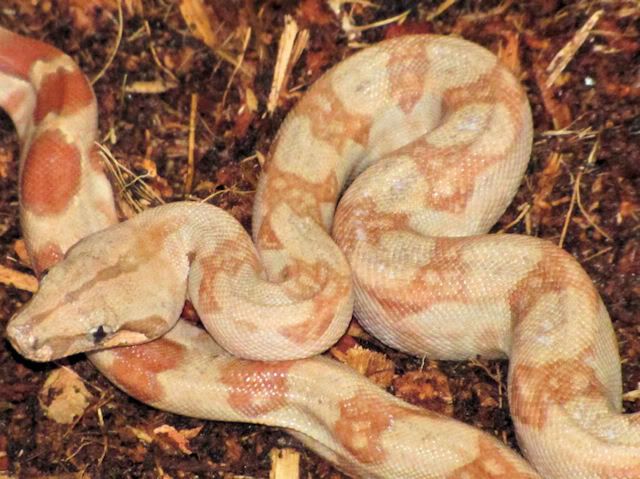Boinae
Boa Constrictor
The boa snakes, skipjack or simply Boas Boas ( Boinae ) are a subfamily of the Boas ( Boidae ). Its distribution area extends across Central and South America to the Pacific, where American Samoa. The genera Acrantophis and Sanzinia occur in Madagascar.
Features
The representatives of the boa snakes are muscular, mostly medium-sized to very large snakes. With the Great Anaconda, the subfamily contains one of the largest snakes in the world. From the sand boas ( Erycinae ) they differ in a number of characteristics of the skeleton, such as postcranial apomorphies, and by the shape of Hemipenisse. In addition, wear some types of boa snakes pit organs, which are always absent in the sand boas.
All boa snakes are ovoviviparous, that give birth to live young. Most species are crepuscular or nocturnal ambush predator, good swimmers and, with the exception of the largest specimens, good climbers. The anacondas are adapted to a largely aquatic lifestyle.
Dissemination and evolution
The current distribution of the boa snakes indicates an origin of the group on Gondwana, from where they are to South America ( genus Boa, Eunectes, Epicrates and Corallus ), Madagascar ( Acrantophis and Sanzinia ) and the Pacific ( Candoia ) were common. Recent analyzes support this assumption by showing that these three groups are also reflected in the molecular relationship analysis. Fossil species are attributed to the boa snakes, but are also known from the Tertiary of Europe, Siberia and North America, the exact assignment on the finds usually consisting of a few vertebrae is often difficult.
System
The boa snakes comprise seven genera with 37 species. Some authors the species of the genera Acrantophis and Sanzinia be placed in the genus Boa, but newer molecular studies support the classification in their own genres.
- Madagaskarboas ( Acrantophis ), two types Southern Madagaskarboa ( Acrantophis dumerili )
- Northern Madagaskarboa ( Acrantophis madagascariensis )
- Boa constrictor (Boa constrictor )
- Pacific Viperboa ( Candoia aspera )
- Pacific tree boa ( Candoia bibroni )
- Pazifikboa ( Candoia carinata )
- Candoia paul soni
- Candoia superciliosa
- Cuban boa ( Chilabothrus angulifer )
- Turk's Iceland Boa ( Chilabothrus chrysogaster )
- Abaco Boa ( Chilabothrus exsul )
- Ford's Boa ( Chilabothrus fordii )
- Wine Boa ( Chilabothrus gracilis )
- Puerto Rican Boa ( Chilabothrus inornatus )
- Mona Boa ( Chilabothrus monensis )
- Silver Grey Boa ( Chilabothrus striatus)
- Haiti Boa ( Chilabothrus strigilatus )
- Jamaican Boa ( Chilabothrus subflavus )
- Ringelboa ( Corallus annulatus )
- Corallus batesii
- Corallus blombergi
- Green tree boa ( Corallus caninus )
- Corallus cookii
- Corallus cropanii
- Corallus grenadensis
- Tree Boa ( Corallus hortulanus )
- Corallus ruschenbergerii
- Argentine rainbow boa ( Epicrates alvarezi )
- Striped rainbow boa ( Epicrates assisi )
- Red rainbow boa ( Epicrates cenchria )
- Paraguayan rainbow boa ( Epicrates crassus )
- Brown rainbow boa ( Epicrates maurus )
- Beni anaconda ( Eunectes beniensis )
- De Look Lake anaconda ( Eunectes deschauenseei )
- Large Anaconda ( Eunectes murinus )
- Yellow anaconda ( Eunectes notaeus )
- Madagascar Hundskopfboas ( Sanzinia madagascariensis )
Protection status
The genus Acrantophis, Epicrates inornatus species, Epicrates monensis, Epicrates subflavus and Sanzinia madagascariensis and the subspecies Boa constrictor occidentalis were recorded as being directly threatened in Appendix I of CITES, which prohibits trade in these animals.
All other types of Boinae are listed in Annex II. This means that the controller must be approved the import and export of animals. In addition, animals that are privately attitude, to the competent authority (municipality and local nature conservation authority ) must be logged.


.jpg)







